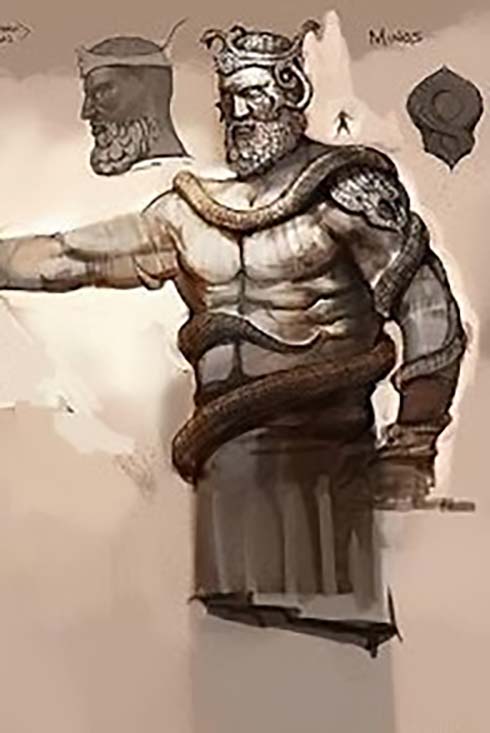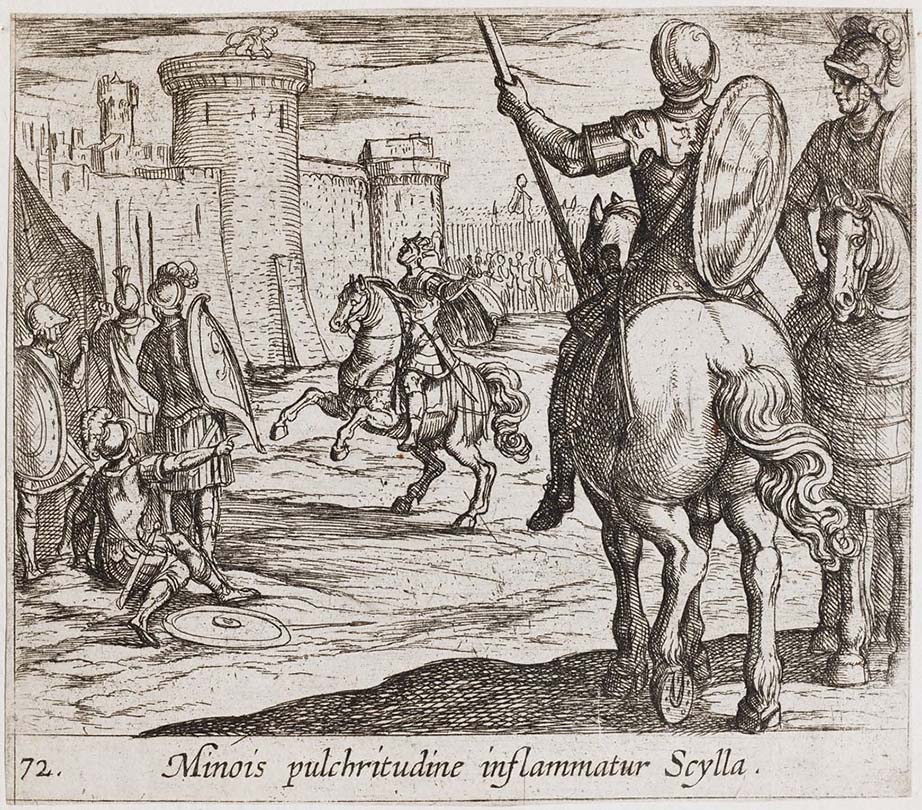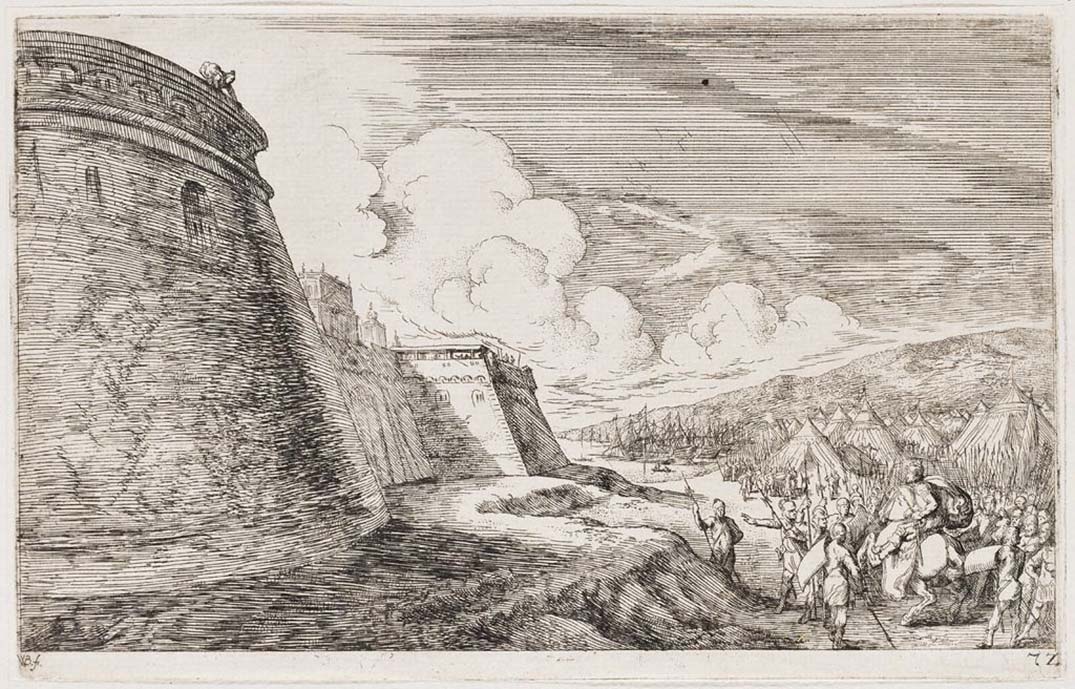
Minos

In Greek mythology, Minos (Ancient Greek: Μίνως) was a King of Crete, son of Zeus and Europa. Every seven years, he made King Aegeus pick seven young boys and seven young girls to be sent to Daedalus's creation, the labyrinth, to be eaten by the Minotaur.
After his death, Minos became a judge of the dead in the underworld.
The Minoan civilization of Crete has been named after him by the archaeologist Sir Arthur Evans.
Literary Minos
Minos appears in Greek literature as the king of Knossos as early as Homer's Iliad and Odyssey. Thucydides tells us Minos was the most ancient man known to build a navy. He reigned over Crete and the islands of the Aegean Sea three generations before the Trojan War.
He lived at Knossos for periods of nine years, where he received instruction from Zeus in the legislation which he gave to the island. He was the author of the Cretan constitution and the founder of its naval supremacy.
On the Athenian stage Minos is a cruel tyrant, the heartless exactor of the tribute of Athenian youths to feed to the Minotaur; in revenge for the death of his son Androgeus during a riot.

Later rationalization
To reconcile the contradictory aspects of his character, as well as to explain how Minos governed Crete over a period spanning so many generations, two kings of the name of Minos were assumed by later poets and rationalizing mythologists, such as Diodorus Siculus and Plutarch— "putting aside the mythological element", as he claims— in his life of Theseus.
According to this view, the first King Minos was the son of Zeus and Europa and brother of Rhadamanthys and Sarpedon. This was the 'good' king Minos, and he was held in such esteem by the Olympian gods that, after he died, he was made one of the three 'Judges of the Dead', alongside his brother Rhadamanthys and half-brother Aeacus.
The wife of this 'Minos I' was said to be Itone (daughter of Lyctius) or Crete (a nymph or daughter of his stepfather Asterion), and he had a single son named Lycastus, his successor as King of Crete.
Lycastus had a son named Minos, after his grandfather, born by Lycastus' wife, Ida, daughter of Corybas. This 'Minos II'— the 'bad' king Minos— is the son of this Lycastus, and was a far more colorful character than his father and grandfather. It would be to this Minos that we owe the myths of Theseus, Pasiphaë, the Minotaur, Daedalus, Glaucus, and Nisus.
Unlike Minos I, Minos II fathered numerous children, including Androgeus, Catreus, Deucalion, Ariadne, Phaedra, and Glaucus — all born to him by his wife Pasiphaë. Through Deucalion, he was the grandfather of King Idomeneus, who led the Cretans to the Trojan War.

Possible historical element
Doubtless there is a considerable historical element in the legend, perhaps in the Phoenician origin of Europa; it is possible that not only Athens, but Mycenae itself, were once culturally bound to the kings of Knossos, as Minoan objects appear at Mycenaean sites.
Minos himself is said to have died at Camicus in Sicily, where he had gone in pursuit of Daedalus, who had given Ariadne the clue by which she guided Theseus through the labyrinth. He was killed by the daughter of Cocalus, king of Agrigentum, who poured boiling water over him while he was taking a bath.
Subsequently his remains were sent back to the Cretans, who placed them in a sarcophagus, on which was inscribed: "The tomb of Minos, the son of Zeus."
The earlier legend knows Minos as a beneficent ruler, legislator, and suppressor of piracy. His constitution was said to have formed the basis of that of Lycurgus for Sparta. In accordance with this, after his death he became judge of the shades in the underworld.
In later versions, Aeacus and Rhadamanthus were made judges as well, with Minos leading as the "appeals court" judge.
Family
By his wife, Pasiphaë (or some say Crete), he fathered Ariadne, Androgeus, Deucalion, Phaedra, Glaucus, Catreus, Acacallis and Xenodice.
By a nymph, Pareia, he had four sons, Eurymedon, Nephalion, Chryses and Philolaus, who were killed by Heracles in revenge for the murder of the latter's two companions.
By Dexithea, one of the Telchines, he had a son called Euxanthius.
By Androgeneia of Phaestus he had Asterion, who commanded the Cretan contingent in the war between Dionysus and the Indians. Also given as his children are Euryale, possibly the mother of Orion with Poseidon, and Pholegander, eponym of the island Pholegandros.
Minos, along with his brothers, Rhadamanthys and Sarpedon, were raised by King Asterion (or Asterius) of Crete. When Asterion died, his throne was claimed by Minos who banished Sarpedon and, according to some sources, Rhadamanthys too.

Mythological Minos
Asterion, king of Crete, adopted the three sons of Zeus and Europa: Minos, Sarpedon and Rhadamanthus. According to the Odyssey he spoke with Zeus every nine years for nine years. He got his laws straight from Zeus himself.
When Minos' son Androgeos had won the Panathenaic Games the king, Aegeus, sent him to Marathon to fight a bull, resulting in the death of Androgeos. Outraged, Minos went to Athens to avenge his son, and on the way he camped at Megara where Nisos lived.
Learning that Nisos' strength came from his hair, Minos gained the love of Scylla and her aid in cutting off her father's hair so that he could conquer the city. After his triumph, he punished Scylla for her treachery against her father by tying her to a boat and dragging her until she drowned.
On arriving in Attica, he asked Zeus to punish the city, and the god struck it with plague and hunger. An oracle told the Athenians to meet any of Minos' demands if they wanted to escape the punishment. Minos then asked Athens to send seven boys and seven girls to Crete every nine years to be sacrificed to the Minotaur, the offspring from the zoophilic encounter of Minos' wife Pasiphaë with a certain bull that the king refused to sacrifice to Poseidon, which he had placed within a labyrinth he commanded his architect Daedalus to build. The Minotaur was defeated by the hero Theseus with the help of Minos' daughter Ariadne.
Glaucus
One day, Glaucus was playing with a ball or mouse and suddenly disappeared. The Curetes told the Cretans "A marvelous creature has been born amongst you: whoever finds the true likeness for this creature will also find the child."
Polyidus of Argos observed the similarity of a newborn calf in Minos' herd, colored white and red and black, to the ripening of the fruit of the bramble plant, and so Minos sent him to find Glaucus.
Searching for the boy, Polyidus saw an owl driving bees away from a wine-cellar in Minos' palace. Inside the wine-cellar was a cask of honey, with Glaucus dead inside. Minos demanded Glaucus be brought back to life, though Polyidus objected. Minos shut Polyidus up in the wine-cellar with a sword. When a snake appeared nearby, Polyidus killed it with the sword. Another snake came for the first, and after seeing its mate dead, the second serpent left and brought back an herb which brought the first snake back to life. Following this example, Polyidus used the same herb to resurrect Glaucus.
Minos refused to let Polyidus leave Crete until he taught Glaucus the art of divination. Polyidus did so, but then, at the last moment before leaving, he asked Glaucus to spit in his mouth. Glaucus did so, and forgot everything he had been taught.
Poseidon, Daedalus and Pasiphaë
Minos justified his accession as king and prayed to Poseidon for a sign. Poseidon sent a giant white bull out of the sea. Minos was committed to sacrificing the bull to Poseidon, but then decided to substitute a different bull. In rage, Poseidon cursed Pasiphaë, Minos' wife, with a mad passion for the bull. Daedalus built her a wooden cow, which she hid inside.
The bull mated with the wooden cow and Pasiphaë was impregnated by the bull, giving birth to a horrible monster, again named Asterius, the Minotaur, half man half bull. Daedalus then built a complicated "chamber that with its tangled windings perplexed the outward way" called the Labyrinth, and Minos put the Minotaur in it. To make sure no one would ever know the secret of who the Minotaur was and how to get out of the Labyrinth (Daedalus knew both of these things), Minos imprisoned Daedalus and his son, Icarus, along with the monster. Daedalus and Icarus flew away on wings Daedalus invented, but Icarus' wings melted because he flew too close to the sun. Icarus fell in the sea and drowned.

Theseus
Minos' son Androgeus won every game in a contest hosted by Aegeas of Athens. Alternatively, the other contestants were jealous of Androgeus and killed him. Minos was angry and declared war on Athens. He offered the Athenians peace if they sent Minos seven young men and seven virgin maidens to feed the Minotaur every year (which corresponded directly to the Minoans' meticulous records of lunar alignments - a full moon falls on the equinoxes once every eight years). This continued until Theseus killed the Minotaur with the help of Ariadne, Minos' lovestruck daughter.
Nisus
Minos was also part of the King Nisus story. Nisus was King of Megara, and he was invincible as long as a lock of crimson hair still existed, hidden in his white hair. Minos attacked Megara but Nisus knew he could not be beaten because he still had his lock of crimson hair. His daughter, Scylla, fell in love with Minos and proved it by cutting the crimson hair off her father's head. Nisus died and Megara fell to Crete. Minos spurned Scylla for disobeying her father. She was changed into a shearer bird, relentlessly pursued by her father, who was a falcon.

Death
Minos searched for Daedalus by traveling from city to city asking a riddle; he presented a spiral seashell and asked for it to be strung all the way through. When he reached Camicus, Sicily, King Cocalus, knowing Daedalus would be able to solve the riddle, fetched the old man. He tied the string to an ant, which walked through the seashell, stringing it all the way through. Minos then knew Daedalus was in the court of King Cocalus and demanded he be handed over. Cocalus managed to convince him to take a bath first; then Cocalus' daughters and Daedalus, with Minos trapped in the bath, scalded him to death with boiling water.
After his death, Minos became a judge of the dead in Hades together with Aeacus and Rhadamanthus. Rhadamanthus judged the souls of Asians, Aeacus judged Europeans, and Minos had the deciding vote.
Minos in art
On Cretan coins, Minos is represented as bearded, wearing a diadem, curly-haired, haughty and dignified, like the traditional portraits of his reputed father, Zeus. On painted vases and sarcophagus bas-reliefs he frequently occurs with Aeacus and Rhadamanthus as judges of the underworld and in connection with the Minotaur and Theseus.
In Michelangelo's famous fresco, The Last Judgment (located in the Sistine Chapel), Minos appears as judge of the underworld, surrounded by a crowd of devils. With his tail coiled around him and two donkey ears (symbol of stupidity), Minos judges the damned as they are brought down to hell (see Inferno, Second Circle).

Notes about Throne Succession in Crete
The first Cretan kings are Archedius, Gortys and Cydon. These are all sons of Tegeates, who founded Tegea in Arcadia. Tegeates was a son of the impious Lycaon, who lived at the time of The Flood (see Mythical Chronology). The three brothers emigrated from Arcadia to Crete, and it is said that the city Gortyna was named after Gortys, and Cydonia after Cydon.
After them, Dorus's son Tectamus sailed to Crete with Aeolians and Pelasgians, becoming king of the island. During the time when he was king of Crete, Zeus carried off Europa from Phoenicia. Tectamus' son Asterius married Europa and became king, being succeeded in the throne by Minos, son of Zeus and Europa.
After Minos, his son Lycastus became king being succeeded by his own son, the more famous Minos. But some affirm that Minos was son of Zeus and Europa. During his reign, Crete had conflicts with Athens and Megara, which are reflected in the stories of the Minotaur, the abduction of Ariadne by Theseus, and the story of Nisus. The architectural creations of Daedalus (the Labyrinth, the Wooden Cow, the Dancing-floor for Ariadne) are from this time. Minos died in Sicily killed by King Cocalus, or by the daughters of this Sicilian king.
Minos was succeeded by Idomeneus, who became leader of the Cretans during the Trojan War. At his return from Troy, he was driven out of Crete by the usurper Leucus. Because of the intrigues of Nauplius (see Agamemnon), Idomeneus's wife Meda became the lover of Leucus while her husband was fighting at Troy. But, as it is told, Leucus killed her along with her daughter by Idomeneus, Clisithyra, and detaching ten cities from Crete, made himself ruler of them. So when Idomeneus, returning from the Trojan War, landed in Crete, Leucus drove him out.

Sources
Homer, Iliad 13.450
Odyssey 11.321.
Thucydides, 1.4.
Herodotus 3.122
Powell, Barry B. Classical Myth. Second ed. With new translations of ancient texts by Herbert M. Howe. Upper Saddle River, New Jersey: Prentice-Hall, Inc., 1998, p. 346.
William Godwin (1876). "Lives of the Necromancers". p. 40.
Diodorus Siculus, Library of History, 4. 60. 3
Plutarch, Theseus §16
Horace, Odes 4.7.21.
Diodorus Siculus, 4.79.
Thucydides 1.4.
Pausanias 3. 2, 4.
Odyssey, 11.568.
Plato, Gorgias; 524
Pseudo-Apollodorus, Library 3.1.2.
Nonnus, Dionysiaca, 13. 220ff.
Hyginus, Poetical Astronomy 2. 34
Stephanus of Byzantium s. v. Pholegandros
Apollodorus, Library 3.1.3.
Hyginus, Fabula 136.
Apollodorus, Library 3.3.1.
Bibliotheke 3.1.3
Diodorus Siculus 4.77.2
John Tzetzes, Chiliades i.479ff
Bibliotheke 3.1.4.
Bibliotheke 3.15.8
Plato, Gorgias 523a and 524b ff
Aeneid VI, 568–572).
Inferno V, 4–24; XXVII, 124–127).
"Wikipedia"
Our Mobile Application
Check out Our Mobile Application "Ancient Greece Reloaded"


